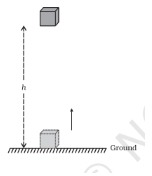
Abhishek DhawanAssistant Manager – Editorial Content
What is Potential Energy?
Potential energy is the energy that an object holds in the starting relative to other objects. The electric charge and other significant factors play a significant role as well. The concept of potential energy was first discovered and understood by physicist William Rankine in the 19th century. There are different kinds of potential energy, and each one of those types is associated with its relative objects and factors.
Formula for Potential Energy
The force between the two objects determines the energy of the object. As per the gravitational force, the following formula can be used to understand the equation properly:
W = m x g x h
OR
W = mgh
- W is potential energy,
- m is the mass in kilograms,
- g is the acceleration of the object due to gravity,
- h is the height of the object in meters.
Unit of Potential Energy
Kinetic energy and potential energy both have the same unit—Kg m2 / s2
It is measured using the SI unit of Joule. All energy has the same units. But in some other cases where the thermodynamics are involved, the SI unit changes to Joule per Kelvin.
Types of Potential Energy
The potential energy is mainly categorised into the following two types:
- Gravitational Potential Energy
- Elastic Potential Energy
Gravitational Potential Energy
When an object rises to a certain height above the ground, the object’s energy at that particular time can be defined as gravitational potential energy. The formula used to calculate the gravitational potential energy is the same:
Work = force x displacement
i.e. mg x h
Therefore, W = m x g x hThe gravitational potential energy can be understood in detail by the following diagram:
The above illustration clearly states the gravitational potential energy. The object is far above the ground in the picture, which depicts the gravitational potential energy.
Elastic Potential Energy
The second type of energy is elastic potential energy. The elastic potential energy can be stretched or compressed in either way. The object needs to be elasticated, pulled from one endpoint to the other to reach an elastic potential so the energy within can work. Some examples of elastic potential energy are as below:
- Rubber band
- Stretch bow of an archer
- Spring of a clock
- Diver board, etc.
Below images describe the elastic potential energy
OR
The above-shown diagrams clearly state the examples of elastic potential energy. Anything that can be compressed or can be stretched is considered an example of elastic potential energy.
Weightage of Potential Energy in Class 11
The chapter ‘Energy’ holds a weightage of 6 marks in total as per the CBSE guidelines. It contains one very short question (2 marks), one objective type question (1 mark), and one short question (2 marks).
Illustrated Examples on Different Types of Potential Energy
Example 1) Illustrate gravitational PE
Answer –
Example 2) Illustrate elastic PE
Answer –
Example 3) What’s the SI unit of potential energy?
Answer – Joule.
[Image Courtesy: NCERT]
FAQs on Types of Potential Energy
Q: How many types of potential energies are there?
Q: What is the correct formula to calculate potential energy?
Q: What’s the unit of potential energy?
Q: List a few examples which can be used to understand/study the concept of elastic potential energy.
- Rubber band
- Stretch bow of an archer
- Spring of a clock
Q: Explain gravitational potential energy.
News & Updates
Work, Energy and Power Exam
Student Forum
Popular Courses After 12th
Exams: BHU UET | KUK Entrance Exam | JMI Entrance Exam
Bachelor of Design in Animation (BDes)
Exams: UCEED | NIFT Entrance Exam | NID Entrance Exam
BA LLB (Bachelor of Arts + Bachelor of Laws)
Exams: CLAT | AILET | LSAT India
Bachelor of Journalism & Mass Communication (BJMC)
Exams: LUACMAT | SRMHCAT | GD Goenka Test




